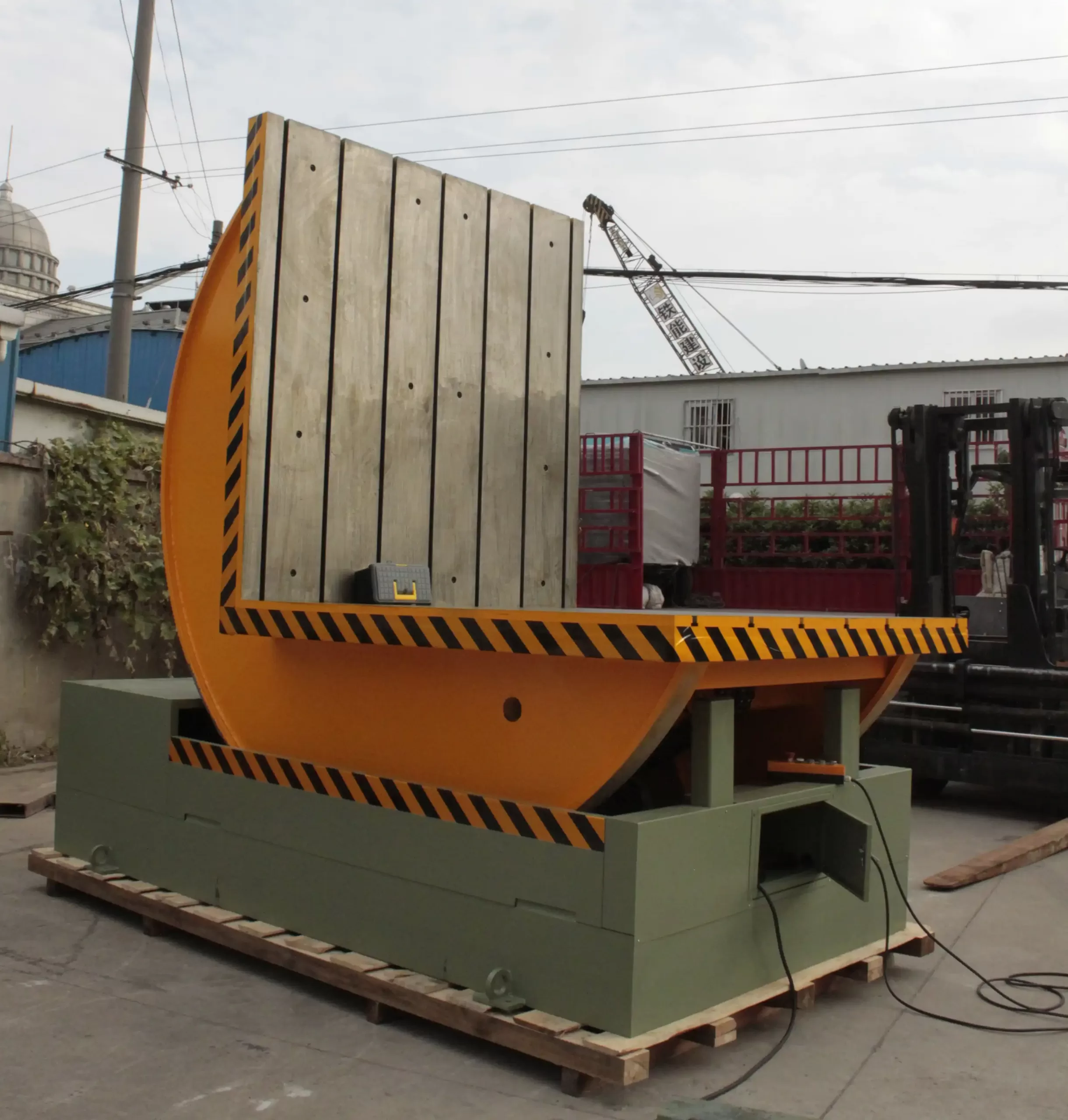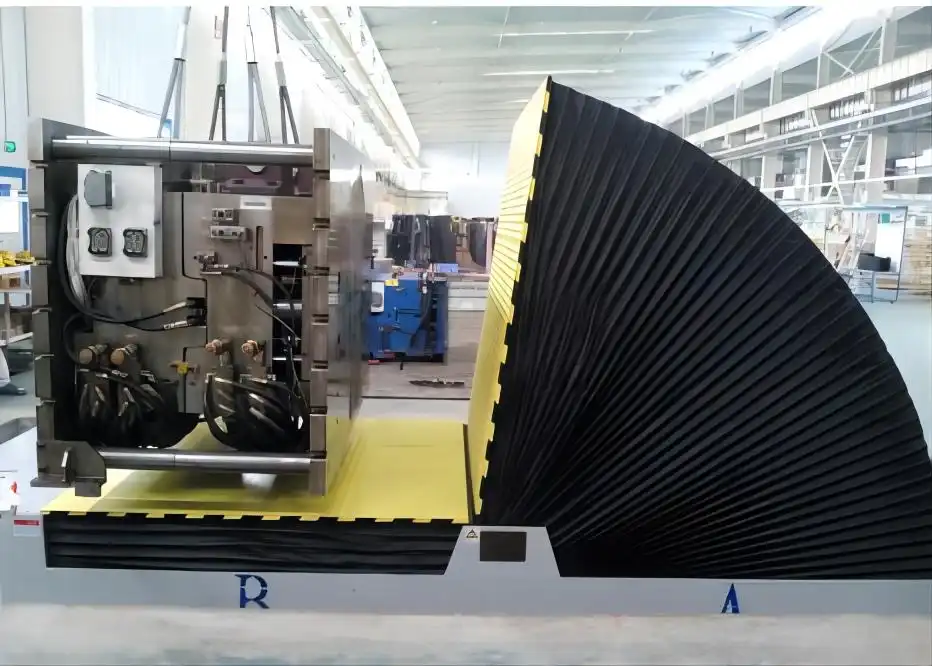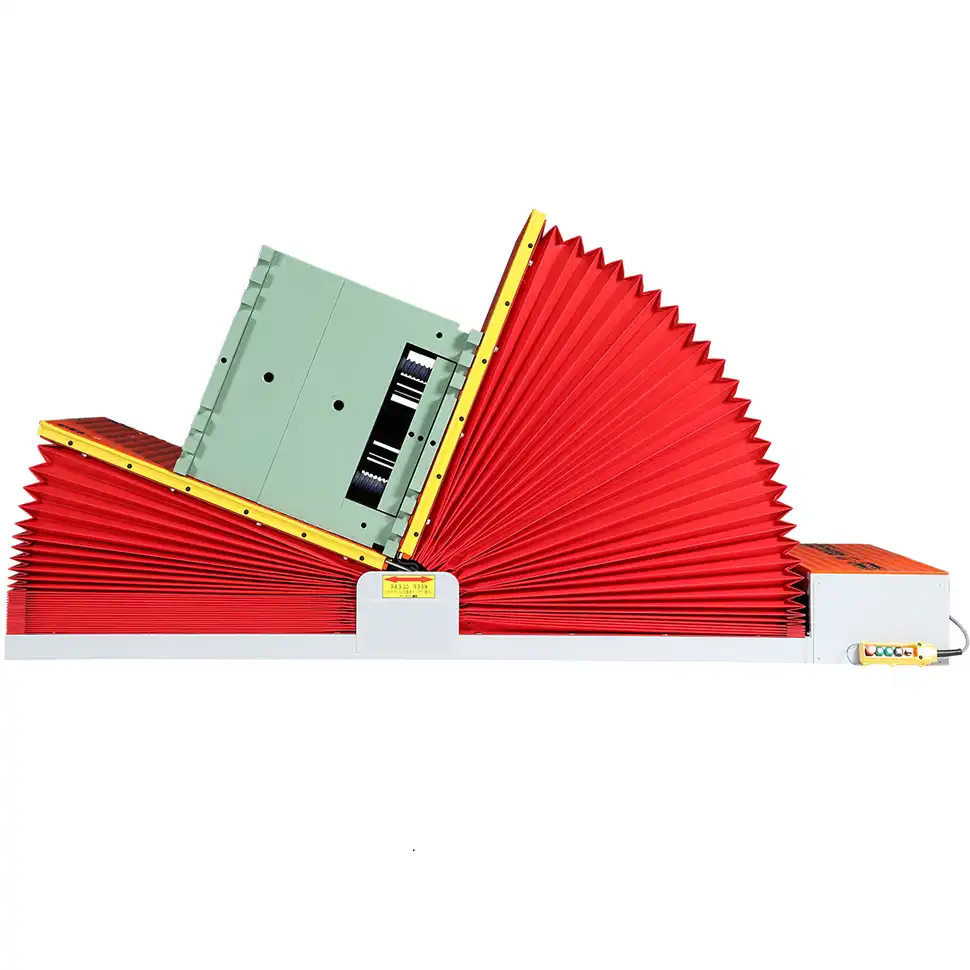How Can Mold Tilting Equipment Reduce Injuries and Downtime in Mexican Factories?
In a busy Mexican steel factory, every minute and every movement counts. I've walked through many plants, just like yours, where giant molds are the heart of the operation. But handling these heavy, awkward pieces of equipment often involves old, risky methods. Using cranes and chains to flip a multi-ton mold is not just slow; it's a disaster waiting to happen. You worry about your workers' safety, the constant risk of accidents, and the production halts that follow. Each incident, even a near-miss, sends ripples through your entire operation, costing you time, money, and morale. This is a problem that keeps many factory owners up at night. The solution is simpler and more effective than you might think: dedicated mold tilting equipment designed specifically for this task. It’s a move towards a safer, more efficient, and more profitable factory.
Mold tilting equipment directly reduces injuries by creating a controlled, mechanical process that eliminates dangerous manual handling and unstable crane lifts. It cuts downtime significantly by making mold maintenance and changeovers faster, more predictable, and less labor-intensive, often reducing a multi-hour task to just a few minutes.

I know you are looking for more than just a piece of machinery. You are looking for a real solution that integrates into your factory and helps you meet your strategic goals. You want to see fewer accidents, less unplanned downtime, and a healthier bottom line. So, let’s break down exactly how this equipment achieves this. We will look at the direct impact on safety, downtime, and even how it fits into the modern, digitized factory you are building.
How does a mold tilter directly improve worker safety in a factory?
The thought of a workplace accident is something every factory owner dreads. In the steel industry, where everything is heavy and powerful, the risk is always present. You might be using overhead cranes and chains to flip your molds for maintenance. This method is common in many factories in Mexico, but it's full of danger. A single weak link in a chain, a moment of miscommunication, or a slight imbalance can lead to a catastrophic failure. This not only endangers your skilled workers but also creates a culture of fear and raises your insurance costs. A dedicated mold tilter is engineered to solve this very problem by taking the unpredictability out of the equation.
A mold tilter improves worker safety by providing a stable, secure platform that mechanizes the entire tilting process. It keeps workers out of the danger zone, eliminates the need for manual pushing or prying, and uses built-in safety features like hydraulic locks and limit switches to prevent accidents before they can happen.

From Uncontrolled Risk to Engineered Safety
When I started as an engineer, I saw firsthand the risks of traditional methods. We used to watch teams of workers carefully position heavy chains around a mold. Then, an overhead crane would slowly lift and turn it. Everyone in the area held their breath. There were too many variables: the crane operator's skill, the strength of the chains, the balance point of the mold. It was an art, not a science, and sometimes the art failed.
Modern mold tilting equipment changes this completely. It turns an uncontrolled process into a repeatable, engineered procedure. The mold is loaded onto a solid, stable table. The operator stands at a safe distance and pushes a button. The machine does the work. This simple change has a massive impact on the safety culture of a plant. It shows your employees that their well-being is a top priority.
Key Safety Features of Modern Mold Tilters
The safety improvements are not just about the general concept; they come from specific design features. Let’s compare the old way with the new way.
| Feature | Old Method (Crane & Chains) | New Method (Mold Tilter) |
|---|---|---|
| Control | Depends on operator skill and external factors. | Fully automated and controlled by a PLC. Consistent and predictable. |
| Stability | The mold is suspended and can swing or slip. | The mold is secured to a stable platform throughout the process. |
| Worker Position | Workers are often close to the suspended load to guide it. | The operator is at a safe distance, away from the machine's movement. |
| Failure Mode | A chain or sling failure results in a catastrophic drop. | Hydraulic and mechanical locks prevent movement in case of power loss. |
| Process Speed | Slow and deliberate, increasing time under a suspended load. | Fast and efficient, minimizing the duration of the operation. |
These machines are built with safety as the primary goal. They include features like heavy-duty construction, emergency stop buttons that are easily accessible, and interlocking systems that prevent operation if the mold is not positioned correctly. For a CEO like Javier, who is focused on both production stability and the well-being of his team, investing in this technology is a clear step towards creating a world-class, safe working environment in his Mexican steel mill.
What is the real impact of mold tilters on equipment downtime?
Every time a production line stops, the clock starts ticking on lost revenue. In a high-capacity steel mill, downtime is the enemy of profitability. You have a goal to get equipment uptime to 95%, but aging machinery and slow maintenance processes make this a huge challenge. A common bottleneck is mold maintenance. When you use traditional methods like cranes to handle molds, the entire process is slow and unpredictable. You have to wait for a crane to be available, clear a large area for safety, and then slowly and carefully perform the lift. This planned downtime can easily stretch from an hour to half a day.
The real impact of a mold tilter on downtime is a dramatic reduction in the time it takes to get a mold ready for maintenance or changeover. By automating the tilting process, it can cut handling time by up to 90%, turning a slow, disruptive event into a quick, routine task and helping you implement a more effective preventive maintenance schedule.

The Hidden Costs of Traditional Mold Handling
The "downtime" you see on a report is often just the tip of the iceberg. The true cost is much higher. It’s not just the time the production line is stopped. It’s the time your maintenance crew spends waiting for a crane. It’s the time other operations are halted because the crane is busy. It's the risk of damaging the mold during the clumsy handling process, which can lead to even longer, unplanned downtime for repairs.
I remember visiting a factory where a mold changeover was scheduled to take two hours. It ended up taking five. The crane was needed for an urgent loading task, so the maintenance team had to wait. This delay caused a cascade of problems down the line, affecting their production schedule for the entire day. These are the kinds of hidden costs that slowly eat away at your 8% cost reduction goal. A dedicated mold tilter, placed right where it’s needed, eliminates these dependencies and delays. It's always available, ready to work.
A Data-Driven Look at Downtime Reduction
Let's put some numbers to this. For a factory owner like Javier, who relies on strict feasibility analysis, the data tells the story. Consider the typical steps involved in tilting a mold for maintenance.
| Task | Traditional Method (Time) | With Mold Tilter (Time) | Time Saved |
|---|---|---|---|
| Crane/Forklift Booking | 15-45 minutes (waiting) | 0 minutes (always available) | 15-45 minutes |
| Area Clearing & Safety Prep | 10 minutes | 2 minutes | 8 minutes |
| Rigging Mold with Chains/Slings | 15 minutes | 5 minutes (placing on table) | 10 minutes |
| The Actual Tilting Process | 10 minutes (slow and careful) | 2 minutes (automated) | 8 minutes |
| Un-rigging and Securing | 10 minutes | 2 minutes (ready for work) | 8 minutes |
| Total Time | 60-90 minutes | ~11 minutes | ~85% Reduction |
This time-saving has a direct impact on your goal of 95% uptime. When a maintenance task that took over an hour now takes about ten minutes, you can do it more often. This allows you to shift from a reactive maintenance model (fixing things when they break) to a proactive, predictive maintenance model. You can inspect and service molds on a regular, planned schedule with minimal disruption. This leads to better mold performance, higher product quality, and a significant reduction in unexpected, costly breakdowns of your aging equipment. It turns a major source of downtime into a streamlined part of your efficient operation.
Can modern mold tilters integrate with existing production lines and digital systems?
You're a forward-thinking leader. You've already invested in smart platforms and are pushing for a digital transformation in your steel mill. The last thing you want is a new piece of equipment that works in isolation, a "dumb" machine in a smart factory. You have a goal to achieve comprehensive production visualization with MES and IoT sensors. A major concern is whether new equipment can speak the same language as your existing systems, especially when dealing with production lines that have equipment over 15 years old.
Yes, modern mold tilters are specifically designed for integration. They can easily connect with your factory's PLC, MES, and IoT networks. This allows them to become an active part of your automated production flow, feeding data back into your systems for monitoring, control, and analysis.

Beyond a Standalone Machine: The Tilter as a Network Node
In the past, a machine like a tilter was just a standalone tool. You pushed a button, and it did its job. That's no longer the case. Today, we design these machines to be intelligent nodes on your factory network. Think of it not just as a piece of hardware, but as a source of valuable data.
Through simple integration with a Programmable Logic Controller (PLC), the mold tilter can communicate its status. Is it in use? Has it completed its cycle? Is there a fault? This information can be sent directly to your Manufacturing Execution System (MES). Now, your production dashboard doesn't just show that a line is down for maintenance; it can show the exact stage of the mold handling process. This is a key step toward the total production visualization you want to achieve. Furthermore, we can equip the tilter with IoT sensors to monitor motor temperature, hydraulic pressure, and cycle counts. This data is crucial for your predictive maintenance goals, allowing you to service the tilter before it ever becomes a problem.
Integration Pathways and Benefits for a Mexican Steel Mill
Integrating a mold tilter is not a complex, theoretical process. It's a practical step with clear benefits for your operation.
| Integration Point | Function | Benefit for Your Steel Mill |
|---|---|---|
| PLC Integration | The tilter becomes part of an automated sequence. It can receive signals from and send signals to conveyors or robotic arms. | Creates a seamless, automated maintenance bay. Reduces manual intervention and human error, increasing efficiency and safety. |
| MES/ERP Connection | The tilter reports its operational status, cycle times, and any error codes to the central system. | Provides real-time visibility into maintenance activities. Helps you track Overall Equipment Effectiveness (OEE) more accurately. |
| IoT Sensors | Monitors machine health (e.g., vibration, temperature, pressure) and transmits data for analysis. | Enables predictive maintenance. Reduces unplanned downtime by fixing issues before they cause a failure, aligning with your 95% uptime goal. |
| Safety System Link | Connects to the factory's safety light curtains or area scanners. The tilter will not operate if a person enters the danger zone. | Enhances worker safety beyond the machine's own features. Creates a foolproof safety environment, reducing accident risk and liability. |
I worked with a client in Monterrey who was implementing a new MES. They were worried that their new coil handling equipment would be a "black box." We showed them how the PLC on our machine could easily be configured to communicate with their system. Within a week, their central control room could see the status of every tilter and upender on the floor. For them, it was a major step in their digital transformation journey. For a leader like Javier, this proves that investing in modern equipment doesn't create new problems; it helps solve existing ones and pushes you closer to your strategic goals.
What is the ROI on investing in a mold tilter for my factory?
As the owner of a steel mill, every investment decision comes down to the numbers. With pressures from fluctuating energy costs and market demand in Mexico, you need to be certain that any capital expenditure will deliver a strong, measurable return. You can't afford equipment that is just a cost center. You are looking for a strategic investment that helps you achieve your goal of an 8% reduction in overall operating costs. So, the critical question is: What is the real Return on Investment (ROI) for a mold tilter?
The ROI for a mold tilter is calculated by adding up the significant savings from reduced labor costs, eliminated production downtime, lower accident-related expenses, and less damage to expensive molds. In most industrial settings, the investment pays for itself within 12 to 24 months, delivering value long after.

My Insight: It's More Than a Machine, It's a Business Strategy
From my journey, from an engineer on the factory floor to owning my own packing machine factory, I've learned that the best investments solve multiple problems at once. A mold tilter is a perfect example of this. On the surface, it’s a machine that flips things. But when you analyze it from a CEO's perspective, it's much more.
It's a safety strategy that protects your most valuable asset: your people. This reduces risk, lowers insurance premiums, and improves morale.
It's an efficiency strategy that directly attacks downtime. By speeding up maintenance, it helps you get closer to that critical 95% uptime goal.
It's a cost-reduction strategy. It saves labor, prevents costly damage to molds, and cuts the hidden expenses associated with production delays.
It’s a future-proofing strategy. Its ability to integrate with digital systems means it’s an investment that grows with your factory, not one that will become obsolete.
When you look at it this way, the question isn't "Can we afford this?" but "How can we afford not to do this?" The cost of one serious accident or a week of accumulated downtime from inefficient handling can easily exceed the cost of the machine itself. This is the kind of practical, high-impact solution I built my own success on, and it’s the kind of solution I am passionate about sharing with leaders like you.
A Sample ROI Framework for Your Analysis
To help with your feasibility analysis, let's create a simplified framework. You can plug in your own numbers from your Mexican factory to see the potential impact.
| Cost/Saving Category | Traditional Method (Annual Cost) | With Mold Tilter (Annual Cost) | Annual Savings |
|---|---|---|---|
| Labor for Tilting | 2 workers x 1.5 hrs/day x 250 days x $10/hr = $7,500 | 1 worker x 0.25 hrs/day x 250 days x $10/hr = $625 | $6,875 |
| Downtime Cost | 1 hr/day downtime x 250 days x $2,000/hr = $500,000 | 0.15 hr/day downtime x 250 days x $2,000/hr = $75,000 | $425,000 |
| Accident Costs (Avg.) | 1 minor incident/year = $10,000 | Reduced risk = $500 (est.) | $9,500 |
| Mold Damage Repair | Est. $5,000/year from handling errors | Est. $500/year (minimal risk) | $4,500 |
| Total Annual Savings | $445,875 |
Let's assume the investment for a suitable mold tilter is $50,000.
Payback Period = Total Investment / Total Annual Savings = $50,000 / $445,875 ≈ 0.11 years, or about 1.5 months.
Even with much more conservative numbers, the payback period is incredibly fast. This isn't just an operational improvement; it's a powerful financial decision that directly supports your goals for cost reduction and increased profitability.
Conclusion
Investing in modern mold tilting equipment is a direct investment in safety, efficiency, and profitability. It solves today’s challenges and prepares your factory for the demands of tomorrow.




